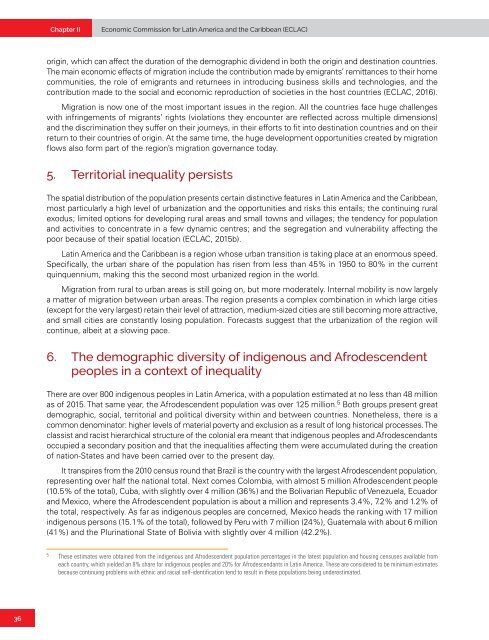Draft first regional report on the implementation of the Montevideo Consensus on Population and Development
This draft report seeks to give an account of progress in the implementation of the priority measures of the Montevideo Consensus on Population and Development in the region, as well as the differences between countries in terms of the degree of implementation. By highlighting relevant national experiences, it also seeks to facilitate the exchange of good practices among countries so that they can benefit from each other in their efforts to advance the implementation of the actions of the Montevideo Consensus.
This draft report seeks to give an account of progress in the implementation of the priority measures of the Montevideo Consensus on Population and Development in the region, as well as the differences between countries in terms of the degree of implementation. By highlighting relevant national experiences, it also seeks to facilitate the exchange of good practices among countries so that they can benefit from each other in their efforts to advance the implementation of the actions of the Montevideo Consensus.
Create successful ePaper yourself
Turn your PDF publications into a flip-book with our unique Google optimized e-Paper software.
Chapter II<br />
Ec<strong>on</strong>omic Commissi<strong>on</strong> for Latin America <strong>and</strong> <strong>the</strong> Caribbean (ECLAC)<br />
origin, which can affect <strong>the</strong> durati<strong>on</strong> <strong>of</strong> <strong>the</strong> demographic dividend in both <strong>the</strong> origin <strong>and</strong> destinati<strong>on</strong> countries.<br />
The main ec<strong>on</strong>omic effects <strong>of</strong> migrati<strong>on</strong> include <strong>the</strong> c<strong>on</strong>tributi<strong>on</strong> made by emigrants’ remittances to <strong>the</strong>ir home<br />
communities, <strong>the</strong> role <strong>of</strong> emigrants <strong>and</strong> returnees in introducing business skills <strong>and</strong> technologies, <strong>and</strong> <strong>the</strong><br />
c<strong>on</strong>tributi<strong>on</strong> made to <strong>the</strong> social <strong>and</strong> ec<strong>on</strong>omic reproducti<strong>on</strong> <strong>of</strong> societies in <strong>the</strong> host countries (ECLAC, 2016).<br />
Migrati<strong>on</strong> is now <strong>on</strong>e <strong>of</strong> <strong>the</strong> most important issues in <strong>the</strong> regi<strong>on</strong>. All <strong>the</strong> countries face huge challenges<br />
with infringements <strong>of</strong> migrants’ rights (violati<strong>on</strong>s <strong>the</strong>y encounter are reflected across multiple dimensi<strong>on</strong>s)<br />
<strong>and</strong> <strong>the</strong> discriminati<strong>on</strong> <strong>the</strong>y suffer <strong>on</strong> <strong>the</strong>ir journeys, in <strong>the</strong>ir efforts to fit into destinati<strong>on</strong> countries <strong>and</strong> <strong>on</strong> <strong>the</strong>ir<br />
return to <strong>the</strong>ir countries <strong>of</strong> origin. At <strong>the</strong> same time, <strong>the</strong> huge development opportunities created by migrati<strong>on</strong><br />
flows also form part <strong>of</strong> <strong>the</strong> regi<strong>on</strong>’s migrati<strong>on</strong> governance today.<br />
5. Territorial inequality persists<br />
The spatial distributi<strong>on</strong> <strong>of</strong> <strong>the</strong> populati<strong>on</strong> presents certain distinctive features in Latin America <strong>and</strong> <strong>the</strong> Caribbean,<br />
most particularly a high level <strong>of</strong> urbanizati<strong>on</strong> <strong>and</strong> <strong>the</strong> opportunities <strong>and</strong> risks this entails; <strong>the</strong> c<strong>on</strong>tinuing rural<br />
exodus; limited opti<strong>on</strong>s for developing rural areas <strong>and</strong> small towns <strong>and</strong> villages; <strong>the</strong> tendency for populati<strong>on</strong><br />
<strong>and</strong> activities to c<strong>on</strong>centrate in a few dynamic centres; <strong>and</strong> <strong>the</strong> segregati<strong>on</strong> <strong>and</strong> vulnerability affecting <strong>the</strong><br />
poor because <strong>of</strong> <strong>the</strong>ir spatial locati<strong>on</strong> (ECLAC, 2015b).<br />
Latin America <strong>and</strong> <strong>the</strong> Caribbean is a regi<strong>on</strong> whose urban transiti<strong>on</strong> is taking place at an enormous speed.<br />
Specifically, <strong>the</strong> urban share <strong>of</strong> <strong>the</strong> populati<strong>on</strong> has risen from less than 45% in 1950 to 80% in <strong>the</strong> current<br />
quinquennium, making this <strong>the</strong> sec<strong>on</strong>d most urbanized regi<strong>on</strong> in <strong>the</strong> world.<br />
Migrati<strong>on</strong> from rural to urban areas is still going <strong>on</strong>, but more moderately. Internal mobility is now largely<br />
a matter <strong>of</strong> migrati<strong>on</strong> between urban areas. The regi<strong>on</strong> presents a complex combinati<strong>on</strong> in which large cities<br />
(except for <strong>the</strong> very largest) retain <strong>the</strong>ir level <strong>of</strong> attracti<strong>on</strong>, medium-sized cities are still becoming more attractive,<br />
<strong>and</strong> small cities are c<strong>on</strong>stantly losing populati<strong>on</strong>. Forecasts suggest that <strong>the</strong> urbanizati<strong>on</strong> <strong>of</strong> <strong>the</strong> regi<strong>on</strong> will<br />
c<strong>on</strong>tinue, albeit at a slowing pace.<br />
6. The demographic diversity <strong>of</strong> indigenous <strong>and</strong> Afrodescendent<br />
peoples in a c<strong>on</strong>text <strong>of</strong> inequality<br />
There are over 800 indigenous peoples in Latin America, with a populati<strong>on</strong> estimated at no less than 48 milli<strong>on</strong><br />
as <strong>of</strong> 2015. That same year, <strong>the</strong> Afrodescendent populati<strong>on</strong> was over 125 milli<strong>on</strong>. 5 Both groups present great<br />
demographic, social, territorial <strong>and</strong> political diversity within <strong>and</strong> between countries. N<strong>on</strong>e<strong>the</strong>less, <strong>the</strong>re is a<br />
comm<strong>on</strong> denominator: higher levels <strong>of</strong> material poverty <strong>and</strong> exclusi<strong>on</strong> as a result <strong>of</strong> l<strong>on</strong>g historical processes. The<br />
classist <strong>and</strong> racist hierarchical structure <strong>of</strong> <strong>the</strong> col<strong>on</strong>ial era meant that indigenous peoples <strong>and</strong> Afrodescendants<br />
occupied a sec<strong>on</strong>dary positi<strong>on</strong> <strong>and</strong> that <strong>the</strong> inequalities affecting <strong>the</strong>m were accumulated during <strong>the</strong> creati<strong>on</strong><br />
<strong>of</strong> nati<strong>on</strong>-States <strong>and</strong> have been carried over to <strong>the</strong> present day.<br />
It transpires from <strong>the</strong> 2010 census round that Brazil is <strong>the</strong> country with <strong>the</strong> largest Afrodescendent populati<strong>on</strong>,<br />
representing over half <strong>the</strong> nati<strong>on</strong>al total. Next comes Colombia, with almost 5 milli<strong>on</strong> Afrodescendent people<br />
(10.5% <strong>of</strong> <strong>the</strong> total), Cuba, with slightly over 4 milli<strong>on</strong> (36%) <strong>and</strong> <strong>the</strong> Bolivarian Republic <strong>of</strong> Venezuela, Ecuador<br />
<strong>and</strong> Mexico, where <strong>the</strong> Afrodescendent populati<strong>on</strong> is about a milli<strong>on</strong> <strong>and</strong> represents 3.4%, 7.2% <strong>and</strong> 1.2% <strong>of</strong><br />
<strong>the</strong> total, respectively. As far as indigenous peoples are c<strong>on</strong>cerned, Mexico heads <strong>the</strong> ranking with 17 milli<strong>on</strong><br />
indigenous pers<strong>on</strong>s (15.1% <strong>of</strong> <strong>the</strong> total), followed by Peru with 7 milli<strong>on</strong> (24%), Guatemala with about 6 milli<strong>on</strong><br />
(41%) <strong>and</strong> <strong>the</strong> Plurinati<strong>on</strong>al State <strong>of</strong> Bolivia with slightly over 4 milli<strong>on</strong> (42.2%).<br />
5<br />
These estimates were obtained from <strong>the</strong> indigenous <strong>and</strong> Afrodescendent populati<strong>on</strong> percentages in <strong>the</strong> latest populati<strong>on</strong> <strong>and</strong> housing censuses available from<br />
each country, which yielded an 8% share for indigenous peoples <strong>and</strong> 20% for Afrodescendants in Latin America. These are c<strong>on</strong>sidered to be minimum estimates<br />
because c<strong>on</strong>tinuing problems with ethnic <strong>and</strong> racial self-identificati<strong>on</strong> tend to result in <strong>the</strong>se populati<strong>on</strong>s being underestimated.<br />
36


















